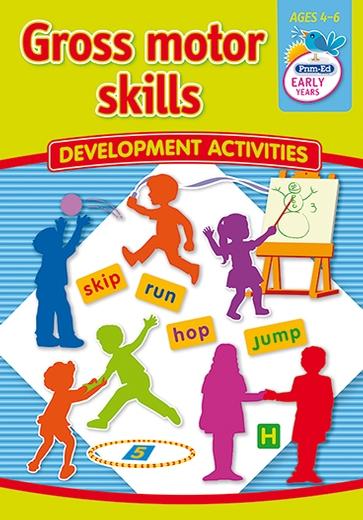-
0
Your cart is currently empty.
-
0
Your cart is currently empty.
Gross Motor Skills
- Format: Photocopiable Books
- Code: 6215 | ISBN: 9781846547041
- Subject: General
- Levels: Preschool, Junior Infants, Senior Infants
Starter activities, puzzles and guides for developing gross motor skills.
Features:
- gross motor skills activities - seven sections - Spatial and body awareness; Locomotor skills; Ball skills; Equipment; Sensory tables; Creative play and games, obstacles and relays activities, games and recipes to develop gross motor skills
- teacher information on body awareness, motor planning, bilateral integration, tactile awareness and early childhood development
- hints and tips for assessing skills
- checklists for pupils appraisal
Supports Aistear's theme of 'well-being' and it's learning goals, including:
- discover, explore and refine gross motor skills
- gain increasing control and co-ordination of body movements.
-
Gross motor skills are involved in the movement and coordination of the arms, legs, and other large body parts and movements. They participate in actions such as running, crawling, swimming, etc. We may notice children at yard, in the line or in our PE classes who may need support in these areas. This book aims to help teachers with activities puzzles and guides to develop those areas. These activities could be utilised in your PE class or at break/yard time. This book breaks down each skill within the gross motor skills into: - Body awareness-the pupil’s ability to know where his/her body is in space. - Motor planning-the pupil’s ability to figure out how to do a new motor task. (bringing the spoon to an ear or a knee instead of the mouth for example) - Bilateral integration-this refers to the pupil’s ability to use both sides of his/her body during an activity. For example, catching a ball or colouring (one hand holds paper, the other holds the pencil) - Crossing the midline-refers to the pupil’s ability to cross over the midline of the body. - Tactile awareness The book gives activities for developing each skill above with some really nice finger plays, action songs and rhymes, perfect to integrate in your language lesson. It also gives two forms of gross motor skills checklist depending on the age of your pupils. There are some really good practical PE “Pick up and go” lesson ideas. You don’t need much equipment, you can use rolled up newspaper or sponges for throwing and catching in or out of the classroom. I like the way this book understand that we have little funding in schools and it seems to be aiming to make developing moving skills easier for teachers and children. This book contains so much for the primary teacher giving parachute/hula hoop/skipping ropes activities as well as sensory ideas like sand tables, water areas, creative play, dramatic, cooking, music, games/obstacles and relay ideas and playdough recipes. I would highly recommend this along with the fine motor skills book for any teacher of Infants up to 3rd Class. It is also very useful for teachers who interested in the play pedagogy/Aistear pedagogy.
Anseo.net -
I recently found a fantastic Prim Ed resource, Gross Motor Skills Development Activities. It would be an amazing resource for Learning Support Teachers, Resource Teachers, Infant Teachers, Aistear, Pre-School Teachers, or parents of children with coordination difficulties. Over the years I have taught many children with Dyspraxia and other coordination difficulties. It’s great to have a resource that you can dip in and out of. Gross Motor Skills Development Activities is very easy to follow and extremely comprehensive: Seven sections which cover- Spatial and body awareness; Locomotor skills; Ball skills; Equipment; Sensory tables; Creative play; and Games, obstacles and relays I have to say that the that I will definitely be using Gross Motor Skills Development Activities when I sit down to plan my P.E Scheme next year. It ticks so many boxes in the P.E Curriculum: - Creative Movement - Travelling - Jumping & Hopping - Throwing & Catching - Rolling - Batting - Parachutes - Hula hoops - Skipping ropes - Games - Obstacles Courses There are also lots of Black Line Masters/BLM’s that would make station teaching so much easier to plan for and set up. They are clear, large and well illustrated.
Miss Mernagh -
When a child gets a diagnosis of dyspraxia/dcd there is usually a list of different recommendations and ideas – however it often requires a huge amount of research on the part of the teacher to figure out what different phrases and ideas mean. The start of this book gives a short summary and some key activities to help the child develop specific skills including body awareness, motor planning, bilateral integration and crossing the midline and tactile awareness. (This is very helpful – especially to anyone new to resource/ dyspraxia). Overall this is a fantastic resource for teachers in junior schools (for P.E. and drama lessons) however, most of it would be easy to adapt for senior classes and also for resource teachers. Since September I have been using a huge range of resources and at last I have found this which covers gross motor skills and is full of useful and practical resources and activities.
irishprimaryteacher.ie


